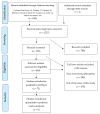Questionnaires Assessing Adolescents' Self-Concept, Self-Perception, Physical Activity and Lifestyle: A Systematic Review
- PMID: 35053716
- PMCID: PMC8774997
- DOI: 10.3390/children9010091
Questionnaires Assessing Adolescents' Self-Concept, Self-Perception, Physical Activity and Lifestyle: A Systematic Review
Abstract
Introduction: Adolescence is considered a fundamental time to promote change. During this time, young people consolidate their social and individual identity. By influencing positive changes, chronic diseases can be avoided, delayed or modified in the future. The use of valid and reliable questionnaires is an optimal resource for gathering information and thus useful for this study.
Objectives: The objectives of the study were to: (1). identify the questionnaires that assess self-esteem/self-concept, self-perception, physical exercise and lifestyle of adolescents; (2). analyse the psychometric measures of the questionnaires used to assess the self-esteem/self-concept, self-perception, physical exercise and lifestyle of adolescents; and (3). determine which questionnaires are the most reliable and valid for assessing the self-esteem/self-concept, self-perception, physical exercise and lifestyle of adolescents.
Method: A bibliographic search was carried out in the following databases: Virtual Health Library, Cochrane, Medline, Cuiden, Scielo, Dialnet, PubMed and Ministry of Health, Consumption and Social Welfare following the PICO method. The recommendations of the PRISMA statement were followed.
Results: A total of 71 scientific articles were collected. Within the self-perception/self-concept questionnaires, the Rosenberg Self-Esteem Scale stands out for being an optimal and widely used resource in adolescents. Regarding the questionnaires that evaluate self-perception, the General Health Questionnaire is the most used; it is used in numerous national health surveys in different countries. The Physical Activity Questionnaire for Adolescents ranks first with respect to the rest of the tools. It is a widely used resource internationally and provides enough information on the physical activity carried out by the subject in a given week. Although there are several questionnaires that measure lifestyle, the Health Behavior in School-aged Children instrument was selected. This instrument is at the European level and involves the collaboration of 48 countries and allows us to compare the lifestyle habits of adolescents from different countries.
Discussion: The questionnaire that stands out in the assessment of self-esteem/self-concept is the Rosenberg Self-Esteem Scale. The General Health Questionnaire has been selected as the best tool for assessing self-perception. To measure physical exercise, the Physical Activity Questionnaire for Adolescents is identified as the ideal instrument because it is widely used and can be completed quickly. Regarding lifestyle, the Health Behavior in School aged Children is shown to be an effective instrument in assessing lifestyle.
Keywords: adolescent; exercise; lifestyle; questionnaires; self-concept; self-perception.
Conflict of interest statement
The authors declare no conflict of interest.
Figures
References
-
- Balsalobre F.J.B., Sánchez G.L., Suárez A.D. Influencia de la condición física en el autoconcepto de un conjunto de adolescentes del municipio de Alcantarilla. Cuad. Psicol. Deporte. 2013;12:57–62.
-
- Luna-Alfaro R., Neira-Esquivel R., Román-Paredes E., Luna-Muñoz C. Autopercepción de la imagen corporal y hábitos alimenticios en estudiantes universitarios, Arequipa 2012. Rev. Fac. Med. 2015;15:4–10.
-
- Videra-García A., Reigal-Garrido R. Autoconcepto físico, percepción de salud y satisfacción vital en una muestra de adolescentes. Anal. Psicol. 2013;29:141–147. doi: 10.6018/analesps.29.1.132401. - DOI
Publication types
LinkOut - more resources
Full Text Sources


